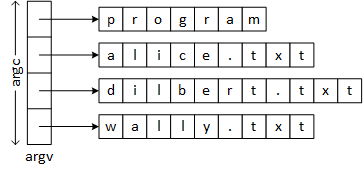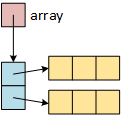| Array Definitions | Memory Allocation |
|---|---|
int array[2][3]; int array[3][2]; |

|
Previously, I stated that when defining a two-dimensional array, the first size is the number of rows, and the second is the number of columns. I'm deliberately using the labels "rows" and "columns" because their meanings are well-established and understood in the context of tables. But does choosing one array index order over the other make a difference? Are we forced to use rows × cols, or can we define it as cols × rows? Again, I'm deliberately using a multiplication notation to make a point: multiplication is commutative, so the product rows × cols is the same as cols × rows, suggesting there is some ambiguity, or, depending on your point of view, some flexibility with the index order.
| Array Definitions | Memory Allocation |
|---|---|
int array[2][3]; int array[3][2]; |

|
Although index order doesn't affect the amount of memory allocated for a two-dimensional array, there are numerous compelling reasons for insisting that the first dimension represents rows and the second columns. So, throughout the text, I maintain that the "correct" index order is rows × cols or array[rows][cols], and attempt to justify my stand in the following sections.
Numerous mathematical operations use vectors and matrices implemented in programs as one- and two-dimensional arrays. Many engineering and scientific disciplines rely on mathematics, including matrix operations.
| Mathematical Matrices | Early Programming Language Matrices | ||||
|---|---|---|---|---|---|
| $$ A = \left[ \begin{matrix} a_{0,0} & a_{0,1} \\ a_{1,0} & a_{1,1} \\ a_{3,0} & a_{3,1} \end{matrix} \right] $$ |
|
IBM created FORTRAN (FORmula TRANslation), the first widely used high-level programming language, in the 1950s for performing mathematical, scientific, and engineering calculations. The illustrated FORTRAN matrix or array is 3 rows by 2 columns. ALGOL, another early programming language and the predecessor of many modern languages like C, C++, C#, Objective-C, Pascal, Ada, etc., also adopted the rows-by-columns order. C++ continues this practice (see, for example, Multidimensional arrays).
Tradition may seem like a poor reason for adopting an index order, but I maintain that it is the best and primary reason. Many algorithms, especially for graphics, modeling, and parallel processes, are expressed in mathematical matrix notation. Programmers frequently translate those algorithms into program functions. In my experience, maintaining a consistent notation eases programming, testing, debugging, and documenting. Furthermore, it enhances readability and increases understanding.
Two array operations suggest that rows-by-columns is the most "natural" array index order. The following figure demonstrates the first, initialization lists, extended to two dimensions. The text covers the second operation, row-major ordering, extensively later in the chapter.
| (a) | #include <iostream>
#include <iomanip>
using namespace std;
int main()
{
char array[3][2] = { 'A', 'B', 'C', 'D', 'E', 'F' };
//char array[][2] = { 'A', 'B', 'C', 'D', 'E', 'F' };
for (int i = 0; i < 3; i++)
{
for (int j = 0; j < 2; j++)
cout << setw(2) << array[i][j];
cout << endl;
}
return 0;
} |
A B C D E F |
| (b) | char array[2][3] = { ... }; for (int i = 0; i < 3; i++) for (int j = 0; j < 2; j++) |
A B D E ä |
| (c) | char array[3][2] = { ... }; for (int i = 0; i < 2; i++) for (int j = 0; j < 3; j++) |
A B C C D E |
| (d) | char array[3][2] = { ... }; for (int i = 0; i < 2; i++) for (int j = 0; j < 3; j++) |
A B C D E F |
C++ implicitly implements two-dimensional arrays as one-dimensional arrays of one-dimensional arrays. This organization allows programs to extract and use individual rows, a one-dimensional array, from a two-dimensional array but not individual columns.
#include <iostream>
#include <iomanip>
using namespace std;
void print_row(char* row, int size)
{
for (int i = 0; i < size; i++)
cout << setw(2) << row[i];
}
int main()
{
char array[][3] = {
'A', 'B', 'C',
'D', 'E', 'F',
'G', 'H', 'I',
'J', 'K', 'L'
};
print_row(array[2], sizeof(array[2]) / sizeof(char));
return 0;
} |
#include <iostream>
#include <iomanip>
using namespace std;
int main()
{
char array[][4] = {
'A', 'B', 'C', '\0',
'D', 'E', 'F', '\0',
'G', 'H', 'I', '\0',
'J', 'K', 'L', '\0'
};
cout << array[2] << endl;
return 0;
}
|
| (a) | (b) |
G H I |
GHI |
| (c) | (d) |
int main(int argc, char* argv[]) int main(int argc, char** argv) |
 |
| (a) | |
argv[row][col] | |
| (b) | (c) |
Java is a pure object-oriented language representing fundamental and structured data differently. It represents fundamental data, int, double, etc., as simple bit patterns in memory. In contrast, it represents structured data, including arrays, as objects - instances of an unnamed class.
public int[][] array = new int[3][2]; |
public int[][] array = new int[2][3]; |
 |
 |
If used consistently, some programs function correctly with either index order. However, some features and the programs utilizing them require a rows x cols or [rows][cols] index order. Other systems require this order, making it customary for C++ programmers. So, throughout this textbook, rows first, followed by columns, is the "correct" order.